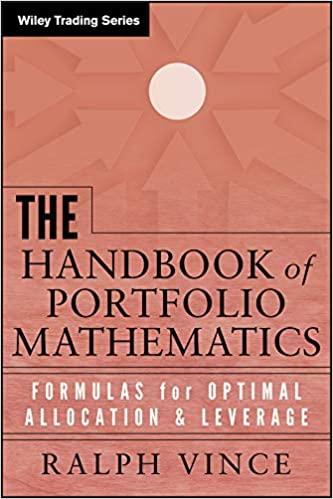Question
Assume that CAT is also contemplating the purchase of a new computer-based order entry system as described in Ex. 14, Chapter 10. Please refer to

Assume that CAT is also contemplating the purchase of a new computer-based order entry system as described in Ex. 14, Chapter 10. Please refer to those CFs you have computed for that specific exercise for NPV and IRR applications.
Application 1: Some financial analysts recommend using debt capital (because debt is typically cheaper than equity), so CAT shall only use long-term bond debt to finance the purchase of the system. As in the web-based Part B of Chapter 07 HW, we have found that the longest-maturity CAT bond (01-March-2097) has a most current "yield to maturity" of 4.900% per year, and thus this 4.900% (per year) on CAT bond is used as the required return for your long-term-debt-financed capital investment.
Based on the required return (financing cost of capital) of 4.900%, if CAT applies the IRR rule, shall CAT purchase the order entry system or not?
Based on the required return (financing cost of capital) of 4.900%, if CAT applies the NPV rule, shall CAT purchase the order entry system or not? (You need to show me the resulting NPV)
Application 2: Some other financial analysts recommend using equity capital (because the bankruptcy risk is smaller for using equity financing instead of bond debt financing), so CAT shall only use common stock to finance the purchase of the system. We thus refer to Chapter 08, "dividend growth model", P0 = D0 * (1 + g)/(R - g) ==> R = D0 * (1 + g) / P0 + g.
Based on our findings in Chapter 08 HW Part B, CAT stock's required return R = D0*(1+g)/P0 + g = xxx% (check Ch. 08 HW sample solutions), and thus this xxx% (per year) on CAT stock is used as the required return for your equity-financed capital investment.
Based on the required return (financing cost of capital) of xxx%, if CAT applies the IRR rule, shall CAT purchase the order entry system or not?
Based on the required return (financing cost of capital) of xxx%, if CAT applies the NPV rule, shall CAT purchase the order entry system or not? (You need to show me the resulting NPV amount.)
Application 3: Based on your answers to Applications 1 & 2, which one of the two financing methods (long-term bond debt vs. common stock equity) would make the order entry system project to be more value-adding to CAT? In other words, CAT wants to maximize shareholders' wealth by trying to earn the largest NPV, so shall CAT choose "long-term bond debt" or "common stock equity" as its financing tool?
EX14. your firm is contemplating the purchase of a new $720000 computer-based order entry system. the system will be depreciated straight-line to zero over its five-year life. it will be worth $75000 at the end of that time. you will save $260000 before taxes per year in order processing costs, and you will be able to reduce working capital by $110000 (this is a one-time reduction). if the tax rate is 35 percent, what is the IRR for this project?
1 Ch. 10: End-of-chapter, "Questions & Problems" 3 Ex. 13 Year 0 Year 1 Yea 2 Year 3 Year 4 Yea 5 8 1) Saes 7 (2) Cost 8 (3) Dop 9 4) EBIT 10 15) Int 11 (6) EBT 12Taxos not yet operational) (not yet operational) S0 tno changes in sales are mentioned S165,000 (each year the cost is savedireduced by $1 S165.000 $112,000 S165.000 165.000 12000$112.000 $165.000 $112,000 $112,000 Note: 1:560.000-0)/5= $112,00 $53,000 (which equals (1)- (2)- (3)) $53,000 53.000 $34,950 $146.980.00 S0 $53.0$18,020 $53,000 (which equals (4)- (5)) $18,020 (which cquais (6). the tax rato 34%) $34,980 (which equals (6) S0 (no intorest expenses are mentianed, nor shal it be coun ted as relevant $18,020 $34.380 Tax Rato $18,020 $34,980 $34.380 OCF yel) 15 OCF 16 17 Attention!!l The above changes occur EVERY year throughout the project life of operations (in this case, for 5 years), not just a single yearl 18 19 Year 20 OCF 21 NCS 22 NWC 23 CFFA 6,980.00 $146.980.00 $146380.00 $146380.00 (Which equals either (4)" (3) . (7), or (B) + (3 56100 tse5,000 taoable gan . (1.34%)= 85,000 . 0.6s-s56, 100} n Ex. 13, "the system requires an initial investment of NWC",so this is a spending - eash outflow in Year 0, and need to be offset 25 Rocuired return giver 21,010.24 (NPV 0. good project) 27 IRR 11.30% (lRR> roured return, good project) 29 Hnts For tho change in NWC alorie, if the rolevant CF is 'nogaive(such as extra speriding on inventory) in Year 0, the relovant CF muel be tho samo amournt but "positive" in the last year 30 And if the reevant CF for NwC Is "postve(such as reduction or savings in inventory spending) in Year 0, the re evant CF must be the same amourt but 'negative n the last year 31 This is the offeeting or recovery oNVC cash lows. The reason for such ofleetling is 32 For long-term fixed assets, their inital asset va ue at Year 0 will be offsete.. cancelled out, recovered) by deprecdiations over multiple years 33 But for net working capial which ncludes current assets & current liablities, such as invertory, accounts receiveble, ete., they are NOT subject to depreciation in accountng: 34 so the anly way to offset NWC is to offset he same amount wth gppos te sian at the last year of the
Step by Step Solution
There are 3 Steps involved in it
Step: 1

Get Instant Access to Expert-Tailored Solutions
See step-by-step solutions with expert insights and AI powered tools for academic success
Step: 2

Step: 3

Ace Your Homework with AI
Get the answers you need in no time with our AI-driven, step-by-step assistance
Get Started


